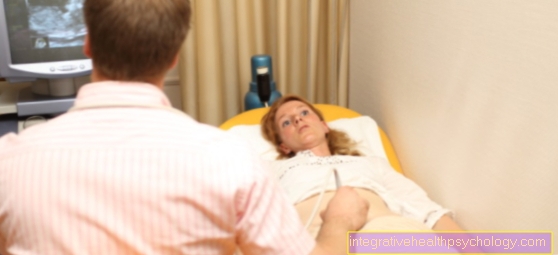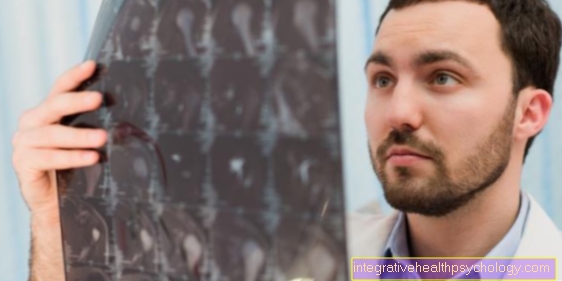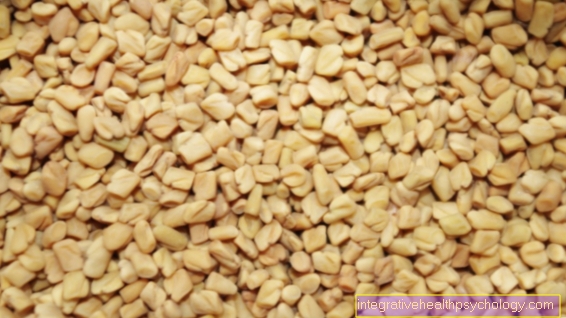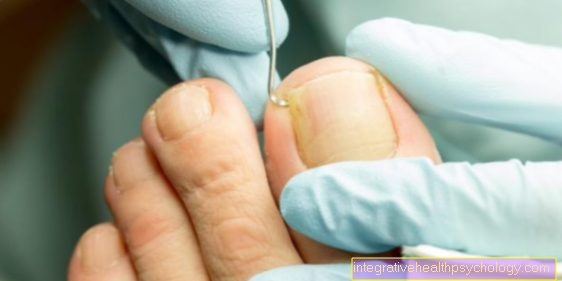Meralgia paraesthetica
General
The Meralgia paraesthetica (Synonyms: Bernhardt-Roth syndrome or Inguinal tunnel syndrome) belongs to the so-called Nerve compression syndromes and comes through the Compression of the lateral femoral cutaneous nerve under the Inguinal ligament conditions.

causes
In principle, anyone can get meralgia paraesthetica.
There are, however certain factorsthat favor their occurrence.
This includes various causes that lead to a high pressure on the inguinal ligament and thus is exerted on the lateral femoral cutaneous nerve, i.e. among other things Obesity, one pregnancy, too tight jeans or belt.
Also a existing diabetes mellitus and the Belonging to the male gender (there are about three men for every affected woman) increase the likelihood of this syndrome.
Origin and symptoms
The lateral femoral cutaneous nerve is constricted or squeezed in its course, which happens most often at its point of passage under the inguinal ligament, since it makes a bend of approximately 90 ° here, according to its natural course.
The nerve arises directly from the lumbar plexus and is purely sensitive, that is, it does not pull into any muscle, but is solely responsible for the sensitivity to the skin on the front outer side of the thigh.
This also explains the symptoms that affected patients describe: In the area of the skin supplied by the nerve, there is paresthesia or pain, which is often described as burning or pinprick-like.
Classically, the symptoms are reduced when the hip is bent, as this relieves the nerve, while the pain tends to increase when the hips are stretched. As the process progresses, in some cases the skin becomes overly sensitive, so that even wearing clothes causes severe pain or the pain perception and the general feeling in this specific area are severely restricted (this is then referred to as Hypalgesia or Hypesthesia). Around one in ten people have problems on both sides.
Also read: Burning in the thigh
Pain
The trapping of a cutaneous nerve in the area of the inguinal ligament causes pain in the thigh. Pain caused by pressure on a nerve is usually dull and burning. Some patients describe it as an electrifying feeling. In the case of meralgia paresthetica, the pain occurs on the outside of the thigh. This area is normally sensitively innervated by the nerve. If the nerve is damaged in its course, there is also a feeling of numbness or unpleasant tingling.
Also read: Nerve pain
Also in the area of the inguinal ligament itself there is pain as part of the compression of the sensitive nerve. Read our article on this: Inguinal ligament pain
therapy
If the suspicion of meralgia paraesthetica has been confirmed, so the doctor injects a local anesthetic into the penetration point of the lateral cutaneous femoral nerve by the Inguinal ligament.
If this significantly improves the symptoms, this is considered to be Proof of existence this disease.
Further therapy depends on the patient.
If a Underlying disease is available, this should in any case treated become.
Also should Avoid risk factors such as tight clothing or being overweight become.
In about 25% of patients forms nerve compression syndrome back on its own.
With the others you can continue local anesthetics (for example Bupivacaine) for nerve block can be used.
In addition, should Pain relievers such as ibuprofen be considered.
surgery
If all these measures do not lead to a reduction in symptoms, an operation can be considered, in which either decompression of the inguinal ligament or even a severing of the affected nerve is carried out.
There are two different procedures behind this term. On the one hand, the nerve can be exposed microsurgically by specialized surgeons and freed from the connective tissue that surrounds and constricts the nerve. On the other hand, the nerve can be injected with certain substances such as 95% ethanol can be obliterated or surgically severed in order to finally eliminate the pain.
In the operation with severing the nerves, the supply area on the thigh remains permanently numb. Motor damage such as muscle paralysis or muscle weakness does not occur with this surgical method.
With all the available treatment options, almost 90% of patients are completely free of symptoms.
physical therapy
Yes, physiotherapeutic treatment is certainly a useful addition to meralgia paresthetics. The pain is caused by the pinched nerve pulling through the inguinal ligament into the thigh. The pressure on the nerve decreases when you bend the hip joint. Corresponding exercises can be learned in physiotherapy. Furthermore, the physiotherapist can loosen the corresponding muscle tension in the thigh, which also helps to relieve pain. Physiotherapeutic treatment is particularly advisable for chronic pain syndromes.
Find out more about the topic here: Pinched nerve on the hip.
Which exercises can help?
Meralgia paraesthetica causes pain in the thigh. The cause is a pinched nerve that pulls from the pelvis through the inguinal ligament into the thigh. Therefore, the symptoms improve when you bend the hip joint. The abnormal sensations increase when the hip joint is hyperextended. This cannot always be avoided in everyday life. However, the pain also often comes at night. Therefore, it helps to put a cushion under the affected leg at night. Relaxation methods such as autogenic training or progressive muscle relaxation according to Jakobsen are also useful as a supplement; especially if the complaints have already become chronic. In addition, one should avoid risk factors such as tight pants, tight car seats or seat belts. Weight loss also eliminates obesity as a risk factor
What is infiltration therapy?
Infiltration therapy for meralgia paraesthetica is comparable to anesthesia at the dentist. In the clinical picture, pressure on a nerve that pulls from the pelvis to the thigh leads to discomfort and pain. Liquid drugs, mostly local anesthetics (for example Lidocaine) or cortisone injected directly into the vicinity of the nerve. You can do this under ultrasound control in order to be able to pinpoint the location. Depending on the success, the treatment can be repeated several times.
Osteopathy
Osteopathy is a complementary medicine procedure. This means that osteopathy is not a diagnosis and therapy method of conventional medicine, but can complement it in certain areas. In osteopathy it is believed that restricted mobility is responsible for the symptoms. Therefore, a major therapy goal is to release these blockages and restore mobility. Sometimes special trigger points are also specifically treated. Trigger points are easily noticeable points at which the pain can be triggered by external pressure.
Medication
Numerous drugs can be used to treat paresthetic meralgia. The drugs of first choice are pain relievers, especially non-steroidal anti-inflammatory drugs (NSAIDs). The best known representative of this class of drugs is ibuprofen. If there is no improvement during therapy with ibuprofen, special nerve pain relievers such as gabapentin, pregabalin or carbamazepine can also be administered. Ibuprofen should be taken as a therapy supplement in this case too. If medication does not provide adequate pain relief, it must be considered whether local (e.g. surgical) therapy is possible.
homeopathy
Relaxing the muscles can bring relief from meralgia paraethetica. Schüßler salts are recommended here, for example No. 7 Magnesium phosphoricum. Arnica can also help treat the symptoms. On the one hand you can try to apply this as an ointment, on the other hand you can also take it in the form of drops or globules.
Meralgia paraesthetica in pregnancy
During pregnancy, the Meralgia paraesthetica affected nerve (Lateral femoral cutaneous nerve) can be compressed or even pinched under the inguinal ligament due to increased pressure in its already very narrow course, which can then lead to the characteristic sensory disturbances in the outer area of the thigh.
During pregnancy, the risk of suffering from meralgia paraesthetica is increased because various changes in the maternal body system occur as the child develops in the womb.
On the one hand, there is increased water retention during pregnancy, among other things. into the connective tissue, which can swell and compress or pinch off surrounding structures (such as nerves). But the increasing weight of the child also causes increased pressure on the pelvis as the pregnancy progresses, as does the increased tension of the abdominal wall, so that irritation of the lateral femoral cutaneous nerve can occur. As a rule, the symptoms disappear after the end of pregnancy without any symptoms remaining.
Meralgia paraesthetica and sports
The Meraligia paraesthetica or the inguinal tunnel syndrome, which is primarily caused by increased tensile and compressive forces on the Lateral femoral cutaneous nerve comes about in its course under the inguinal ligament, can be triggered, among other things, in the context of sporting activities.
In sport, the main risk factor for the development of this nerve irritation is strength training, in which the muscle groups of the thighs (Thigh extensor), the hip (Muscle flexors) and belly (straight and oblique abdominal muscles) be trained.
Incorrect training or poor posture during strength exercises can result in pinching of the nerve on the one hand, but it can also be unbalanced on the other Strength training the resulting imbalances and muscle shortening lead to a compression of the nerve in its anatomical constrictions, so that it is irritated and irritated and causes the characteristic symptom of meralgia paraesthetica on the outside of the thigh.
Which doctor treats meralgia paresthetica?
As a general practitioner, the general practitioner is the first point of contact. He can make the diagnosis and begin the first drug therapy measures. If the general practitioner's therapeutic measures do not improve, a referral to a specialist makes sense. This can be a specialist in neurology on the one hand or a specialist in orthopedics on the other. Both specialists treat this clinical picture. If surgical decompression is planned, a presentation to the surgeon is the right step.
Prognosis / healing
There are numerous known risk factors that favor the development of the disease. These should first be eliminated in order to relieve the nerve. The symptoms often improve spontaneously. If this is not the case, infiltration therapy can be carried out (see above). In rare cases, only surgery can help. However, the prognosis for the disease is good. In nine out of ten patients, these measures lead to a significant improvement in their symptoms.
Diagnosis
In order to be able to make the diagnosis of meralgia paraesthetica, first of all the Medical history survey necessary then a good one physical examination should follow.
Besides the characteristic pain in the circumscribed area the outer front of the thigh is also often noticeable Tenderness somewhat in the middle of the anterior superior iliac spine, this is the point at which the nerve passes through the inguinal ligament.
Passive lifting of the extended leg in the supine position also often increases the pain (inverted Lasègue symbol). It can also be used in some patients pathological SEPs (somatosensitive evoked potentials), which are noticeable by an extended latency. In exceptional cases, it can make sense to use a MRI to have made in order to be able to assess the structures around the inguinal ligament and the nerves.
Differential diagnosis
An important differential diagnosis of meralgia paraesthetica is one Radiculopathy, thus a symptom which is caused by the Damage to a nerve root is triggered. The crucial difference is that with radiculopathies (for example with a Disc prolapse of the lumbar spine) in addition to the sensitive also motor impairments consist.





























